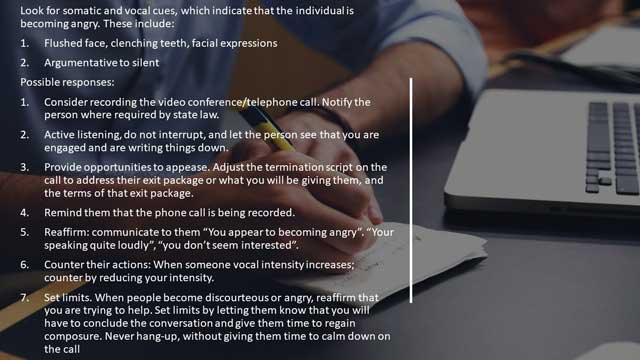« Back to Facilities Management Security Category Home
Security Should Be Involved If Pandemic Brings Layoffs
May 27, 2020
- Security
By Sean A. Ahrens
Over the course of a few weeks, I have had a common discussion with security directors about the RIF, which also goes under other euphemistic namesakes such as the re-organization, layoffs, furloughs, right-sizing, and similar. Regardless of the term, it all ends with the common theme — people are going to lose their jobs. The process is difficult for people making the RIF decision, and certainly for the people experiencing the RIF.
The COVID-19 event has created substantial workloads on all staff, and literally — while senior leaders focus on the granularity of business — security, human resources, and a myriad of others are challenged with their day-to-day tasks, new tasks regarding COVID-19 exposures, work-at-home initiatives, and now the RIF.
Termination processes are very different now. For many employers, employees who will be selected for a downsizing are likely not on premise. Many employees may have additional company property, such as computers, copiers, monitors, cell phones, etc. Other employees may have access to or manage sensitive data/systems. Certainly, we do not want to summon these employees from their home for a termination process. Equally not ideal, social distancing guidelines force employers to notify its employees of this decision via the impersonal and undesirable medium — video conference or telephone.
During my discussions, I listed out considerations. Certainly, this is not exhaustive, but it is starting point to avoid unnecessary grievances and workplace violence issues.
• With so many distractions, security could be left out of the RIF discussion. Security directors should proactively reach out to HR and ask to support the RIF process. Security directors should communicate to HR the possibility of "exiting" red-flagged personnel from the organization.
• Make sure to include your information technology brethren in these discussions. More than ever, IT will be needed to support this process. Examples: How will you terminate network and computer access? How fast can it be done? Does it require actions such as locking or restarting a computer? What data is resident on employees machines? How will personal contacts be distributed? What about mobile technologies?
• Make sure that you have simple/short de-escalation training for Webex/Power Point for managers, supervisors and HR professionals. De-escalation is rooted in defusing emotional energy. (See image below.)

• Establish a risk assessment process. Could an employee become violent? Do they have a support group? What do they have access to? What could they sabotage? Can they get back into building? What network access do they have? What equipment do they have, and how important/expensive is the equipment? Involve IT so they can weigh in on assets their department is responsible for. The outcome of the risk assessment process? Highest risk employees should be released first. Why? So they are not tipped off by others, and attempt mischievous acts.
• Timing is critical, and how you approach communication equally important. One of the key reasons to terminate on a Tuesday or Thursday is to let people vent and heal. In a world of hyper-connectivity they actually might not be able to communicate with them — no home phone number, no access to messaging service. Determine if there is a way for you to compartmentalize network access, so they can can use select services and communicate with employees, but no longer have access to company resources.
• Catalog what equipment employees have and update your termination lists.
Update policies and procedures regarding trespassing and returning to work, unless it's work-related.
• Some may elect to terminate via a video conference, to make it more personal. This is a double edged sword. Unlike a personal meeting, somatic cues will be very important. Rehearse termination processes, build scripts, have an agenda, and work through a no-win situation. Be prepared to set limits and pause to allow people to process information. Ensure you have a pen and paper, and write down all their comments — make sure that the camera's view will allow the person to see you writing down the comments.
• The termination process should not be a dialog. It should be short, sweet, direct, and framed solely around a business decision. Make sure you're looking at the camera, and not another monitor — your attention should be fully on the person.
• Make commitments and keep them. Smiling is not a good idea; it's a somber moment. As always maintain the dignity of the person. Do not rush the person and ensure that you do not schedule more terminations than you can mentally handle in a day. Have at least one hour between calls.
• Establish a process/options for the employee to obtain their belongings by mail or return to work to retrieve their personal belongings with an escort. If you plan on sending items, make sure you catalog everything and pack items very well. Show that you care about their items.
• Many employees have company property under the new work-at-home scheme. Tie and stagger severance payments over one to six months and make them contingent on: not returning to workplace, returning company property and credentials/keys, etc.
• Provide alternatives to appease. It's a difficult time for them. Consider extending medical benefits and providing access to employee assistance programs, counseling, job placement services, testimonial letters, preferred option to return, and similar.
Sean A. Ahrens (sahrens@aeieng.com), CPP, FSyl, CSC, is a resiliency leader/expert security consultant and security market group leader with Affiliated Engineers Inc., a multi-disciplinary engineering firm that provides security consulting, assessment and security design solutions for all types of buildings and sits on the board of the International Association of Professional Security Consultants (IAPSC).









